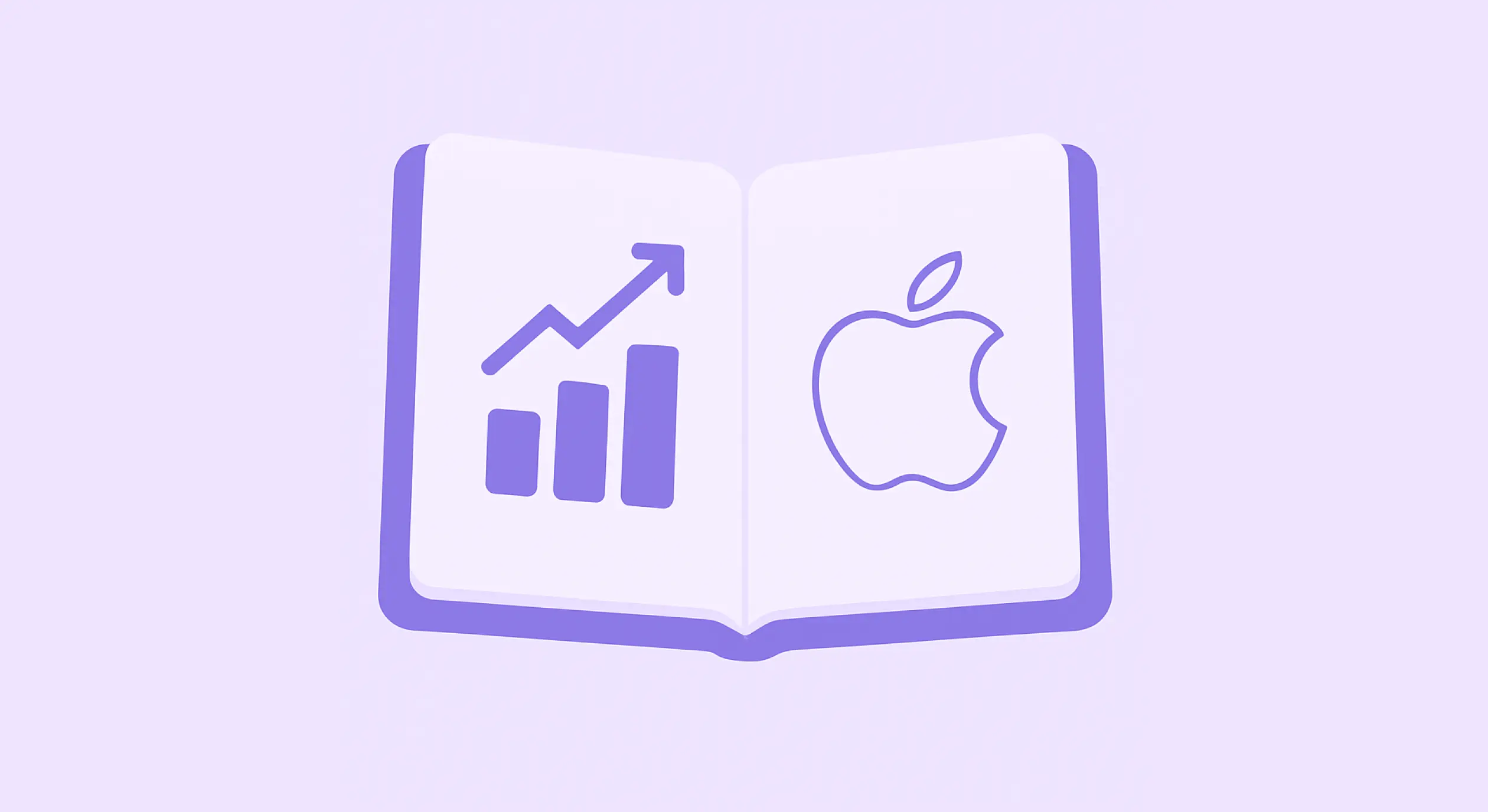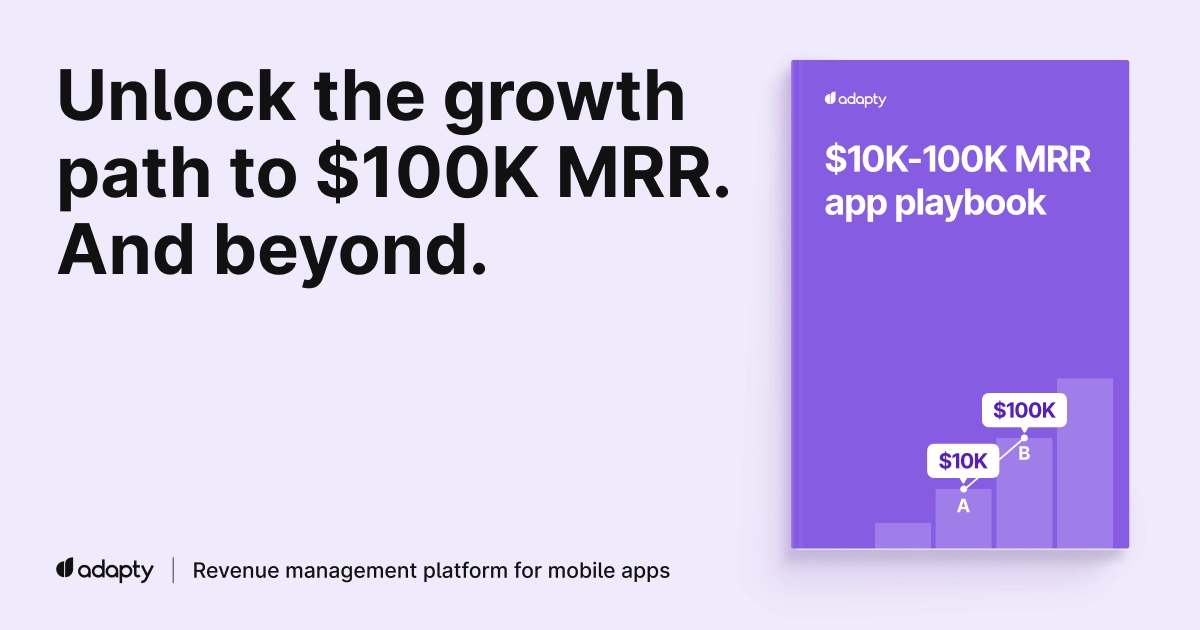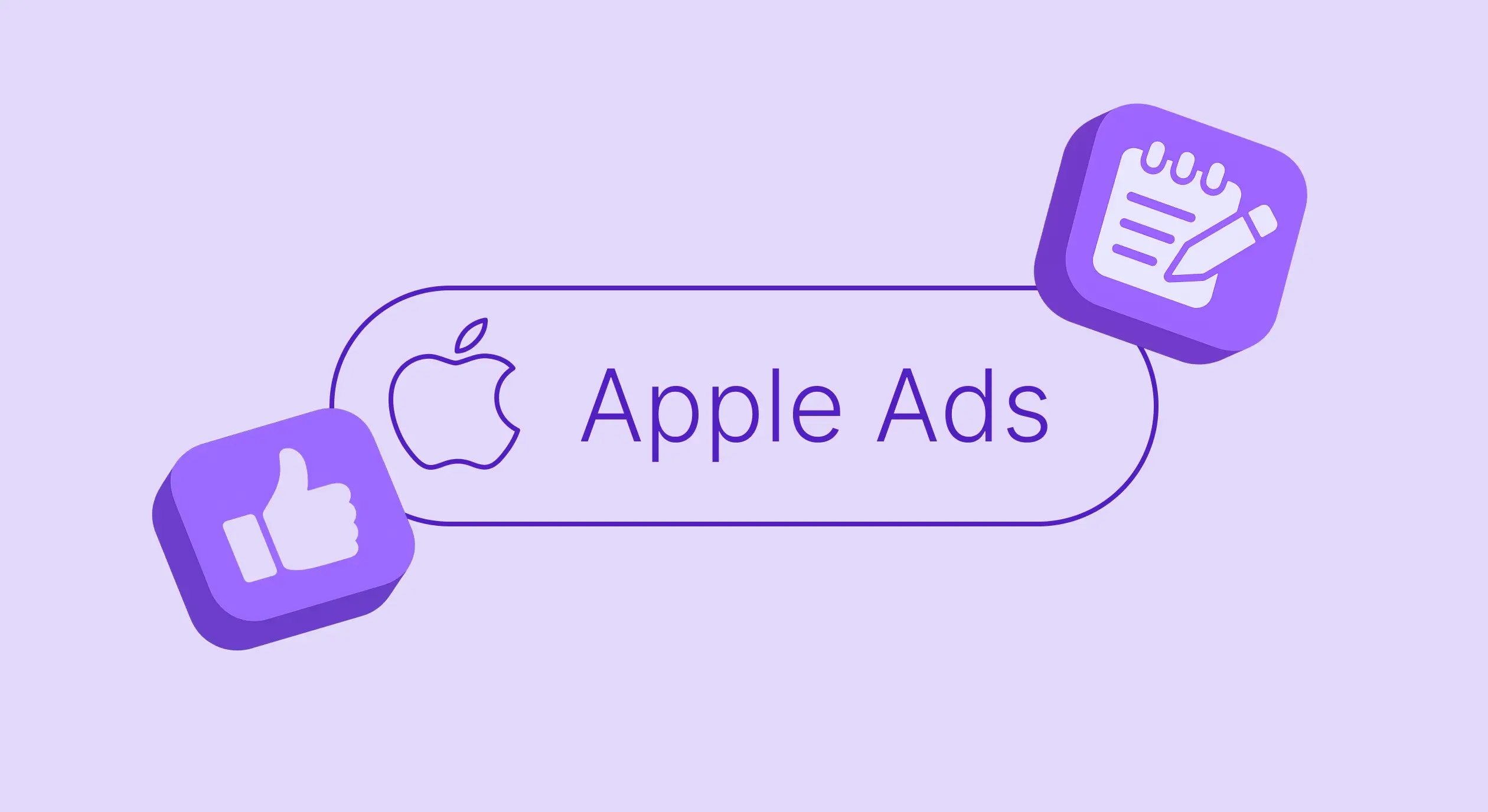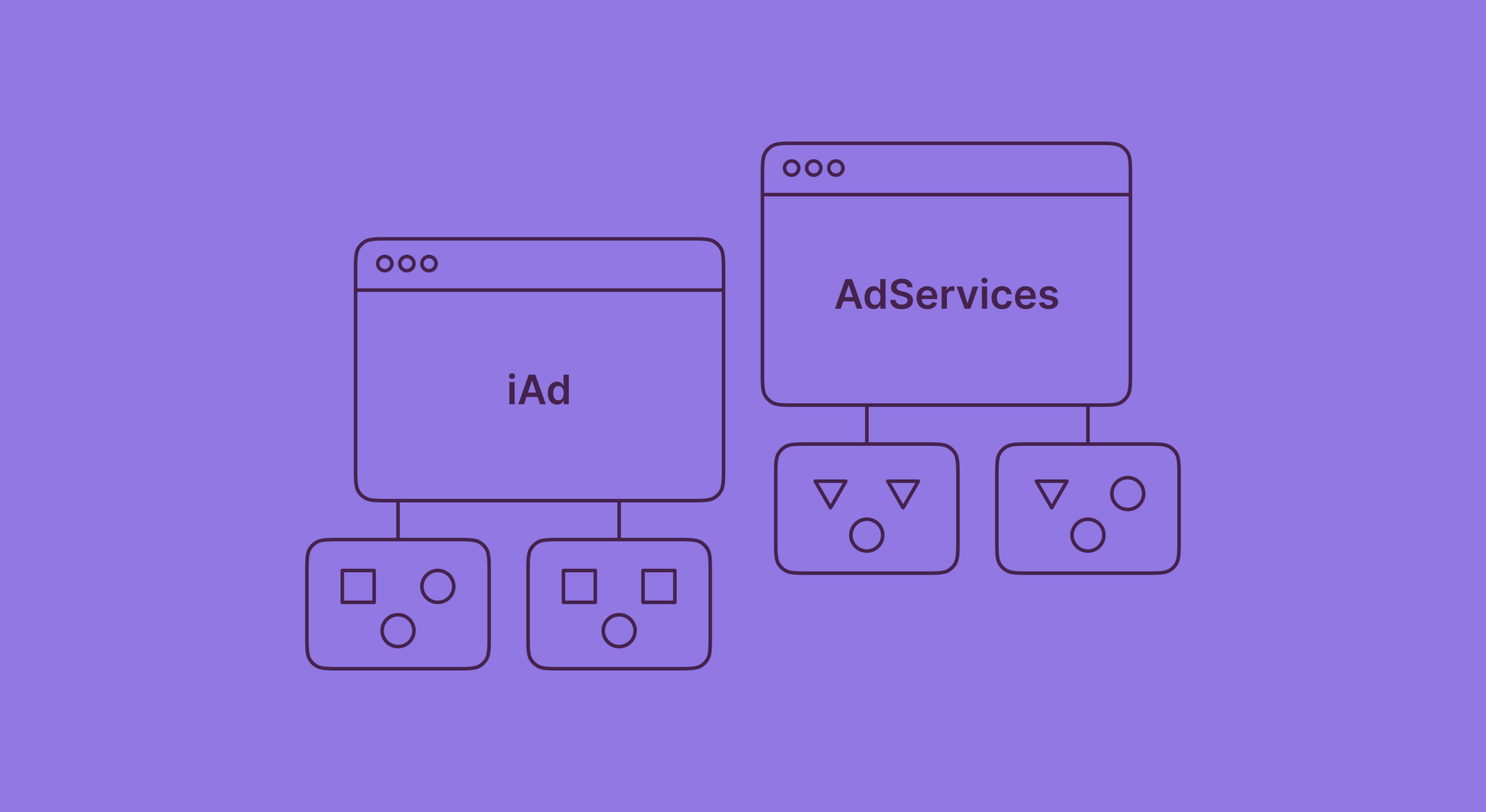TL;DR: Effective Apple Ads analysis starts with proper attribution setup to track subscription revenue, not just downloads. Use Share of Voice analysis to identify scaling opportunities, segment users by acquisition keywords for personalized experiences, and focus on ROAS metrics rather than vanity metrics. Key optimization tactics include dynamic keyword discovery, bid optimization based on impression share, and Custom Product Pages matched to search intent.
Apple Ads delivers 60%+ conversion rates, but most subscription apps struggle to scale profitably because they focus on the wrong metrics and lack proper analysis frameworks. The difference between successful campaigns and budget drains comes down to analyzing the right data and optimizing for subscription revenue, not just installs.
Most advertisers are optimizing for the wrong outcomes. They’re focused on downloads while their actual business runs on subscriptions. It’s like judging a restaurant by how many people walk through the door instead of how much they spend on dinner.
In this guide based on insights from our recent webinar, we’ll walk through how to set up proper analysis infrastructure and the optimization strategies that actually move the needle for subscription apps.
What makes Apple Ads different for subscription apps?
Before diving into analysis techniques, you need to understand why Apple Ads requires a completely different analytical approach than other channels.
1. Attribution without App Tracking Transparency headaches
Here’s the critical advantage most people miss: Apple Ads attribution doesn’t rely on App Tracking Transparency prompts or SKAdNetwork setup. This means you can track deep conversion events, like subscription activations, renewal rates, and lifetime value, with complete confidence in your attribution data.
For subscription apps with complex conversion funnels, this changes everything. You can accurately measure not just who downloaded your app, but who completed onboarding, started trials, converted to paid subscriptions, and remained active months later.
2. High-intent users require different analysis
Apple Ads reaches people actively searching for solutions in the App Store. With over 600 million weekly active users, you’re accessing them at the moment they’re most likely to download an app. This high-intent traffic converts differently than social media or display traffic, requiring specialized analysis approaches.
How to set up proper Apple Search Ads analysis?
Effective analysis starts with the right campaign structure and attribution setup. Without these fundamentals, you’ll be optimizing based on incomplete or misleading data.
Essential campaign structure for clean analysis
The recommended structure for subscription apps includes:
- Brand defense campaign → targeting your app name and branded terms.
- Competitor campaign → targeting competitor app names and branded keywords.
- Generic terms campaign → targeting category and feature-related keywords.
- Discovery campaign → using Apple’s Search Match algorithm to find new keywords.
Key insight from our webinar: Treat your Discovery Campaign as a keyword research engine, not a permanent acquisition channel. Set lower bids and budgets for Discovery, then migrate proven keywords to dedicated campaigns with higher budgets.
This approach prevents the classic mistake of letting Discovery campaigns eat your budget on irrelevant traffic while starving your proven keywords of investment.
How do I track subscription revenue from Apple Ads?
For subscription apps, you need to track beyond downloads to subscription revenue. With Adapty, you can integrate Apple Ads attribution with just a few clicks through the AdServices framework, no MMP required. This integration allows you to analyze:
- Revenue and MRR by keyword and campaign
- ARPU by acquisition source
- LTV calculations in real-time
- Cohort analysis showing user behavior over time
- Subscription conversion rates at different intervals
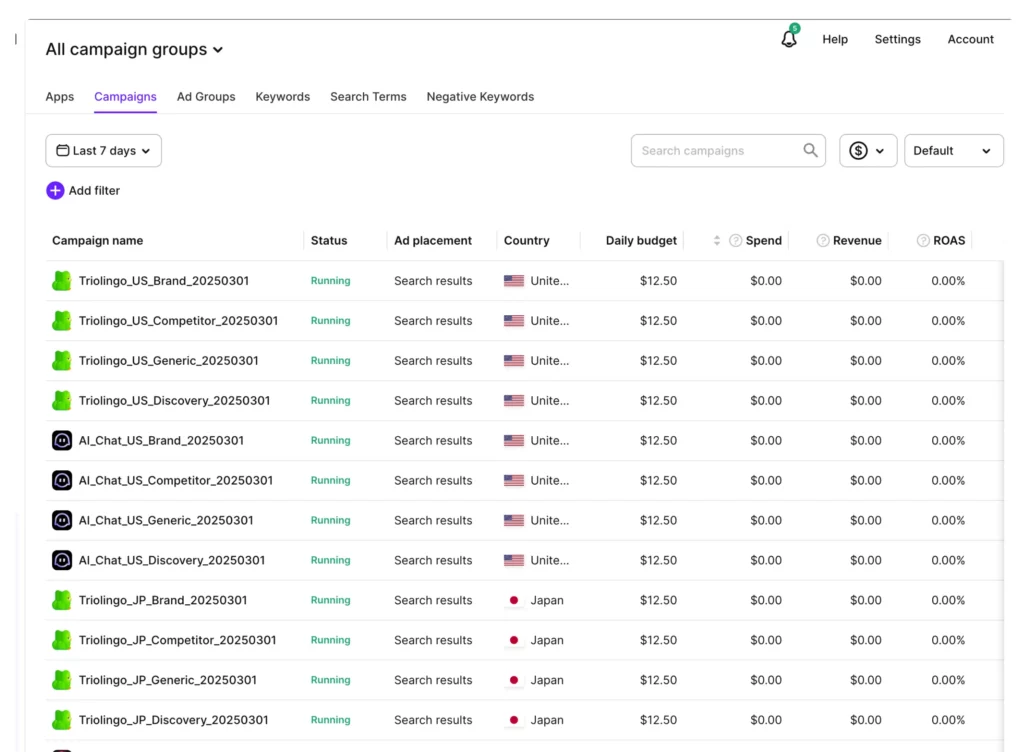
Pro tip: Most attribution setups focus on first-session events. For subscription apps, you need to track the entire user journey from download to renewal, sometimes spanning months.
What Apple Search Ads metrics should I analyze?
Most Apple Ads advice focuses on vanity metrics that don’t correlate with business success. Here’s what actually drives profitable growth.
Focus on revenue metrics
ROAS is everything. Not CPC, not installs, not tap-through rates. Only ROAS tells you whether campaigns generate profitable growth.
Key metrics to track:
- Cost per subscriber (not just cost per install)
- LTV:CAC ratio by keyword cluster
- Subscription conversion rate by acquisition source
- Revenue attribution down to the keyword level
- Churn patterns by traffic source
Think about it this way: Would you rather have 1,000 downloads that generate $500 in revenue, or 100 downloads that generate $2,000? The math is obvious, but most campaign optimization completely ignores it.
Share of Voice analysis for scaling opportunities
One of the most powerful but overlooked metrics is impression share by keyword. Apple reports this in ranges (like 90-100%), and understanding these ranges reveals scaling opportunities most advertisers miss.
The 90% rule → if you have 90-100% impression share for a well-performing keyword, you’ve maximized that keyword’s potential. Focus additional budget on new keywords rather than increasing bids further.
Budget vs Bid analysis:
- Low impression share + not spending full budget = increase bids
- Low impression share + spending full budget = increase daily budget
- High impression share + good performance = test lowering bids to free up budget
This framework prevents the common mistake of endlessly bidding up on keywords you’ve already maximized, while missing opportunities to expand your reach.
How do I know which keywords drive high-value subscribers?
Keyword analysis goes beyond basic performance metrics to understand user intent and conversion patterns, the secret to sustainable scaling.
User segmentation by acquisition keywords
Not all downloads convert equally. Users searching for “free fitness app” have completely different intentions than those searching for “personal trainer app.”
Create intent-based segments:
- Price-sensitive users: “free app,” “cheap app” keywords
- Feature-focused users: “calorie counter,” “workout tracker” keywords
- Premium users: “professional app,” “premium features” keywords
Analyze each segments:
- Subscription conversion rates
- Time to first payment
- Lifetime value
- Churn patterns
This segmentation reveals why some keywords that look expensive deliver your highest-value customers, while “cheap” keywords might be bleeding money through high churn rates.
Dynamic keyword discovery analysis
To maximize the effectiveness of your Discovery campaign, implement what we call a dynamic pipeline where:
- The Discovery campaign is assigned lower bids and lower daily budgets than other campaigns.
- Once keywords in the Discovery campaign prove efficient (measured by conversion rate), add them as negative keywords in the Discovery campaign.
- Add the proven keyword to relevant campaigns in exact match targeting with higher budgets and bids.
- This allows the Discovery campaign to continue finding new keywords while your proven keywords scale in dedicated campaigns.
This approach ensures that performing keywords can scale with higher budgets while your Discovery Campaign continues to find new opportunities.
Seasonal and competitive analysis
Monitor keyword performance patterns to identify:
- Seasonal opportunities: fitness spikes in January, educational apps before school seasons
- Competitive budget cycles: cost drops when competitors hit monthly/quarterly limits
- Market timing: increased search volume around industry events or trends
Understanding these patterns lets you capitalize on opportunities while competitors are asleep at the wheel.
When should I increase vs. decrease my Apple Ads bids?
Analysis is only valuable if it leads to actionable optimizations. Here’s how to turn insights into improved performance.
Bid optimization based on auction analysis
Apple’s auction system factors in tap-through rates, not just bid amounts. Since Apple gets paid per tap, they consider expected revenue when determining winners.
Optimization strategies:
- Improve tap-through rates through Custom Product Pages to win auctions at lower bids
- Test minimum effective bids for high-impression-share keywords to free up budget
- Increase bids strategically based on Share of Voice gaps, not daily performance fluctuations
Most advertisers bid emotionally based on yesterday’s spend. Smart advertisers bid strategically based on auction dynamics and long-term profitability.
Campaign structure optimization
As campaigns mature, evolve your structure based on performance data:
- Level 1: Basic keyword grouping by theme
- Level 2: Separate high-ARPU keywords into dedicated campaigns
- Level 3: Individual campaigns for best-performing keywords with Custom Product Pages
This progression ensures you’re not over-engineering from day one, but you’re also not stuck with a structure that limits your scaling potential.
Personalization based on keyword analysis
Use keyword data to create personalized experiences:
- Custom Product Pages: Match landing page content to keyword intent (sports keywords see sports features, meditation keywords see mindfulness content)
- Segmented paywalls: Show different subscription offers based on acquisition keywords — weight loss keywords see fitness-focused pricing, productivity keywords see business-plan options
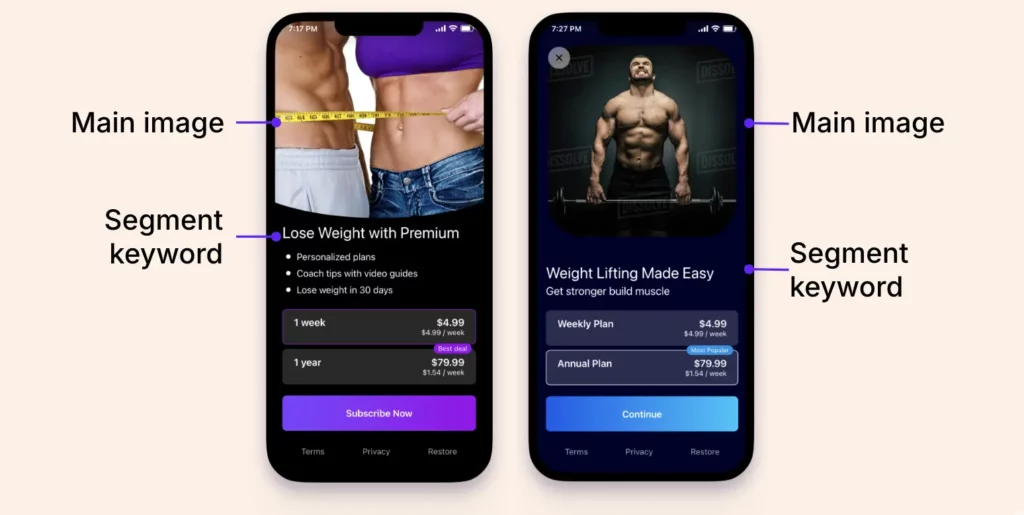
- Targeted push notifications: Send keyword-specific messages using the same language that drove acquisition
This level of personalization can improve conversion rates by 20-40% compared to generic experiences.
Are my brand campaigns just stealing organic downloads?
Brand defense campaigns often show great metrics but may just be capturing organic traffic. Here’s how to measure true impact:
Calculating Cost Per Protected Install
- Pause brand campaigns for 1-2 weeks (if possible).
- Monitor organic download changes during the pause.
- Calculate protected installs (downloads lost when pausing).
- Calculate cannibalized installs (downloads that continued organically).
- Determine true cost per protected install.
This analysis often reveals that brand defense is less efficient than it appears, freeing up budget for growth-focused campaigns.
Competitive timing analysis
Monitor competitors’ budget patterns to find opportunities:
- End-of-month cost drops when competitors hit budget limits.
- Seasonal competition changes around industry events.
- Impression share increases during competitor budget gaps.
Smart timing can reduce your CPCs by 20-30% during these windows.
How do top performers scale their Apple Search Ads?
Once you have solid analysis infrastructure, these advanced techniques can significantly improve performance.
AI-powered keyword discovery
Beyond traditional keyword research, use AI tools trained on App Store data to:
- Identify keyword clusters around successful terms
- Predict seasonal opportunities before competitors notice
- Find related keywords in adjacent categories
- Analyze competitor keyword strategies
Cohort analysis by acquisition source
Segment cohort analysis by keyword clusters to understand:
- Long-term value differences between keyword types
- Retention patterns by search intent
- Subscription renewal rates by acquisition keyword
- Expansion revenue potential from different user segments
Cross-campaign budget optimization
Use performance data to automatically shift budgets:
- Pause underperforming keywords based on ROAS thresholds
- Increase budgets for high-Share-of-Voice opportunities
- Reallocate spend from saturated to opportunity keywords
- Schedule budget increases around seasonal peaks
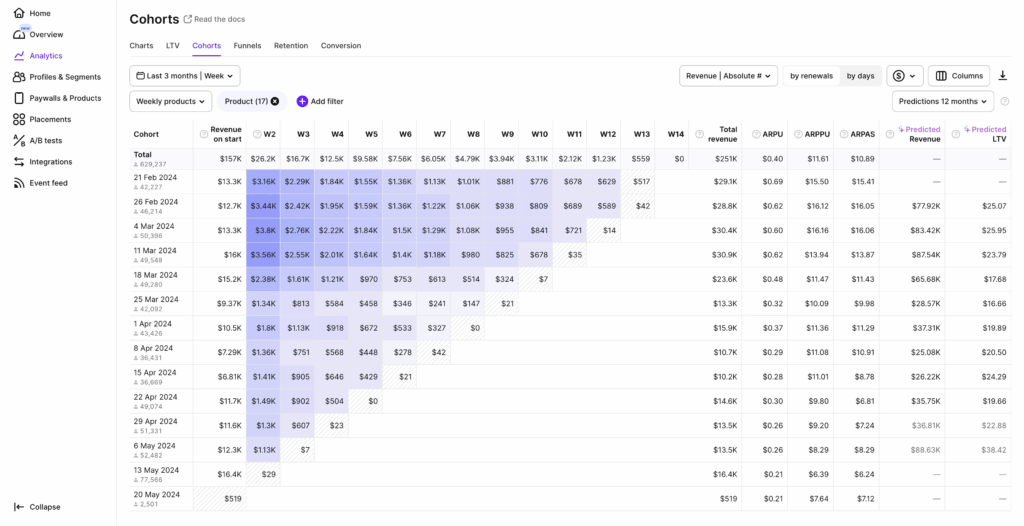
What Apple Ads analysis mistakes should I avoid?
1. Focusing on vanity metrics
Mistake: Optimizing for low CPC or high CTR without considering subscription conversion
Solution: Always tie optimizations back to revenue metrics and LTV
2. Insufficient data thresholds
Mistake: Making optimization decisions with 2-3 days of data
Solution: Wait for statistical significance—typically 50+ taps or 1 week minimum
3. Ignoring user intent differences
Mistake: Treating all keyword traffic the same way
Solution: Segment analysis and optimization by keyword intent and user behavior
4. Over-optimization
Mistake: Constantly adjusting bids based on daily performance fluctuations
Solution: Use Share of Voice and weekly trends to guide bid changes
These mistakes are campaign killers because they create optimization based on noise rather than signal.
How often should I optimize my Apple Ads campaigns?
Successful Apple Search Ads optimization requires systematic processes, not just one-time optimizations.
Weekly analysis routine
- Review Search Terms reports for new keyword opportunities and irrelevant traffic
- Analyze Share of Voice data to identify scaling opportunities
- Check cohort performance by keyword segment for LTV insights
- Monitor competitive patterns for budget timing opportunities
Monthly strategic reviews
- Evaluate campaign structure against performance data
- Test new Custom Product Pages for top-performing keywords
- Refresh seasonal keyword strategies based on upcoming trends
- Review attribution setup to ensure accurate revenue tracking
Quarterly optimization cycles
- Major campaign restructuring based on 3 months of performance data
- Geographic expansion testing for proven keyword sets
- Advanced segmentation implementation for personalization
- Budget allocation strategy updates based on market changes
What should I do first to improve my Apple Ads?
Effective Apple Ads analysis and optimization for subscription apps requires moving beyond basic metrics to focus on revenue attribution, user segmentation, and systematic optimization processes.
Key takeaways for sustainable success:
✅ Set up proper attribution to track subscription revenue, not just downloads
✅ Use Share of Voice analysis to identify real scaling opportunities
✅ Segment users by keywords for personalized experiences that improve conversion
✅ Focus on ROAS and LTV metrics rather than vanity metrics like CPC
✅ Build systematic processes for ongoing analysis and optimization
✅ Test personalization strategies based on keyword intent and user behavior
The most successful subscription apps treat Apple Ads analysis as an ongoing strategic function, not a set-and-forget campaign management task. When you build proper analysis infrastructure and optimization processes, you create a sustainable competitive advantage that compounds over time.
Remember: Your goal should be acquiring subscribers who deliver long-term value, not just driving downloads. When you analyze and optimize with that focus, Apple Ads becomes a powerful engine for sustainable subscription growth.
This article is a comprehensive recap of our recent webinar “Scaling subscriptions with the power of ASA and ASO” featuring Simon from AppTweak and Murat from Adapty.
Just getting started with Apple Ads? Read the Apple Ads beginner’s guide: From setup to revenue optimization to lay a strong foundation. Ready to scale smartly? Check out the Apple Ads guide: Best practices for expert-level strategies and campaign design.
Ready to implement these strategies? Start with proper attribution setup using Adapty’s one-click Apple Search Ads integration and begin tracking the metrics that actually matter for your subscription business.
